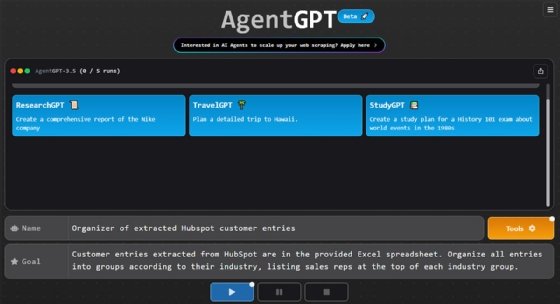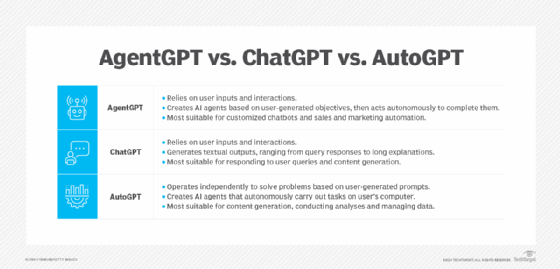AgentGPT
What is AgentGPT? AgentGPT is a generative artificial intelligence tool that enables users to create autonomous...
What is AgentGPT?
AgentGPT is a generative artificial intelligence tool that enables users to create autonomous AI agents that can be delegated a range of tasks. The tool is designed to work autonomously, with some degree of human interaction and supervision. It carries out objectives such as automating routine tasks and creating customized chatbots.
Reworkd AI launched AgentGPT in April 2023 as an open source project and still maintains the tool. The San Francisco startup has three co-founders: CEO Asim Shrestha, CTO Adam Watkins and COO Srijan Subedi. The GPT in its name means that like ChatGPT, AgentGPT is predicated on OpenAI's GPT-3.5 and GPT-4. The tool accesses them to create AI agents, which are pieces of software that act autonomously.
AI agents are given objectives from users and then perform actions based on their own decision-making abilities. These objectives include automatable tasks in fields such as marketing, finance and healthcare. The tool creates and deploys these agents to users' web browsers. Other nascent AI models with similar capabilities include BabyAGI and AutoGPT.
How does AgentGPT work?
Users begin by providing a name for their agent, assigning objectives for the agent and deploying it. They then provide an example showing how to complete the objective. From there, the agent acts autonomously, taking appropriate actions to achieve the objective. Autonomous AI agents can think, plan, reason and execute step-by-step tasks to complete the overall objective, and can be customized to suit a user's specific needs.
The tool responds to human input using two subsets of machine learning: natural language processing (NLP) capabilities and deep learning. It uses GPT-3.5 or GPT-4 as the underlying engine for learning and reasoning, much like ChatGPT. Because AgentGPT is accessed via the web and operates on user prompts without requiring coding or other technical knowledge, it's accessible to many users.
AgentGPT capabilities
AgentGPT includes many of the same features and functionalities that AI-based personal assistants offer, beginning with the ability to access data from existing large language models, or LLMs, that other well-known platforms such as ChatGPT also use. The basic capabilities of AgentGPT include the following:
- Real-time generation. AgentGPT uses GPT-3.5 and GPT-4 to generate textual outputs in real time.
- Customization. Users can build customizable applications such as proprietary chatbots or automation instances.
- Compatibility. AgentGPT is accessed via the web and is compatible with different web browsers.
- Security. AgentGPT authenticates users to prevent unauthorized access to agents or projects. Authorized users can then be managed within the system.
- Accessibility. AgentGPT offers a user-friendly interface and is accessible to users who aren't developers, much like no-code and low-code AI applications.
Creating an agent using AgentGPT
There are four essential steps involved in creating an agent with AgentGPT. The tool doesn't require coding experience to create and run an agent, therefore technical and nontechnical users alike can use it. The steps include the following:
- Access. AgentGPT is accessed via the Reworkd AI website and made available to users with or without an account. Setting up an account isn't required, yet it allows access to more features. More technical users can use an OpenAI application programming interface key to access the most advanced settings the tool offers.
- Assemble. To create an agent, it must be given a name and an objective. The text boxes for both appear on the main page. The objective should be as detailed as possible to avoid any confusion or misinterpretation by the agent. In the example below, the name of the agent is Organizer of extracted HubSpot customer entries; it's tasked with organizing data entries. The goal instructs the agent to organize thousands of customer data entries according to the industries in which they work, while prioritizing sales reps. The Tools button is where to connect the agent with external tools so that it can access data.

Reworkd AI
- Configure. The settings menu is accessed via the left sidebar. It is used to configure various settings, such as the GPT model of choice and language.
- Deploy. Once the agent is set up, the Deploy Agent option will trigger it to act and complete the desired objective. Users must oversee the agent's progress while it's running; this can be viewed from the site's main page.

Reworkd AI
AgentGPT vs. ChatGPT
AgentGPT and ChatGPT are both advanced NLP tools that require user input and function through interactions with those users. However, there are key differences in capabilities and uses. ChatGPT can be classified as a chatbot with generative AI capabilities, while AgentGPT is an autonomous AI tool.
ChatGPT is a highly sophisticated chatbot that answers questions on a seemingly limitless range of complex topics and can hold conversations. It's useful in fields such as customer service. AgentGPT creates and deploys autonomous agents that are assigned goals. It is able to think, reason and act appropriately to achieve those goals, which aren't limited to answering user queries and holding conversations.
Prompts or requests from users are used to initiate both tools. ChatGPT's outputs are a direct response to human inputs, while AgentGPT's decision-making and actions are predicated on initial input on objectives and goals from a user.

AgentGPT vs. AutoGPT
AutoGPT is also an advanced NLP tool, created as an open source autonomous AI application that uses GPT-4, as well as internet browsing capabilities, to independently complete complex goals. The main difference between AutoGPT and AgentGPT is that AgentGPT is web-based, while AutoGPT runs on users' computers and carries out its objectives there.
As previously mentioned, AgentGPT requires user input and interaction. AutoGPT, on the other hand, is designed to operate independently and work off its own prompts to solve tasks.
AgentGPT excels when applied to tasks such as customized sales or marketing automation, where human input initiates and guides how an agent completes them. AutoGPT is more suitable for tasks where the tool has full autonomy to act, such as generating new content, conducting research and analyses, and managing data.
AgentGPT limitations
AgentGPT is a powerful tool showcasing advancements in automation and autonomous AI, yet there is still room for improvement. It might not benefit everyone equally due to the following limitations:
- Costs. AgentGPT offers a free version with access to GPT-3.5; the Pro and Enterprise versions use GPT-4, but aren't free. It's likely that bigger projects requiring more autonomous agents will be more costly in the long run.
- Limits on free version's features. GPT-3.5 is allowed for the free version, which means users can only enter text-based prompts and expect text-based outputs, whereas GPT-4 is multimodal and can interpret other forms of input.
- Supervision. Despite the autonomous nature of the tool, users must ensure outputs are accurate and adequate.
- Data quantity and quality. Users must ensure AgentGPT gets all the data it needs to act autonomously. For example, when a chatbot agent is created, the quality of its outputs is determined by the quality of its training data. If the training data quality is poor, users can't expect their chatbot agent to work properly.
- Prompt quality. Users must ensure the prompts and objectives they provide are well crafted and delivered with clearly defined goals. Otherwise, the agents might misinterpret what needs to be done and act in unexpected ways.
AgentGPT applications and uses
The following are examples of AgentGPT use cases:
- Written content generation. The tool can generate various forms of written content, such as full in-depth news articles and short social media posts. To do this, it needs direction regarding topic and style.
- Code generation. Like other prominent AI coding tools, developers can use AgentGPT to generate code snippets and debug code.
- Marketing assistance. AgentGPT can assist with marketing strategies, such as search engine optimization and creating targeted advertisements.
- Communications. The tool can automate certain automatable workflow processes, such as email communications.
- Chatbots. Users can create customized chatbots for their organizations to assist with answering questions from customers and troubleshooting issues.
- Budgeting. The tool can create financial plans and provide help with budgeting.
- E-commerce platforms. AgentGPT can build e-commerce platforms and also handle inventory management and customer interactions.
Is AgentGPT free?
The Reworkd AI website offers three plan options that consider users' needs and how many agents they'll need. A free version of AgentGPT is available. It uses GPT-3.5 and is best for individual users or small businesses looking to run five or fewer agents. This option comes with less advanced capabilities and features.
The Pro option is for organizations with larger projects. It costs $40 per month and enables up to 30 agents per day. It uses GPT-4 and has more advanced features. An Enterprise option offers the same capabilities as Pro, but with even more flexibility. Features and pricing for this version are determined based on an organization's projects and needs.
AgentGPT is one of many new generative AI tools that are used to apply the power of AI to business development projects. Learn about the different categories of generative AI that can be used for development projects.





